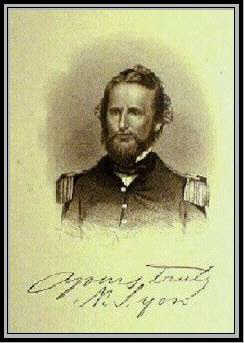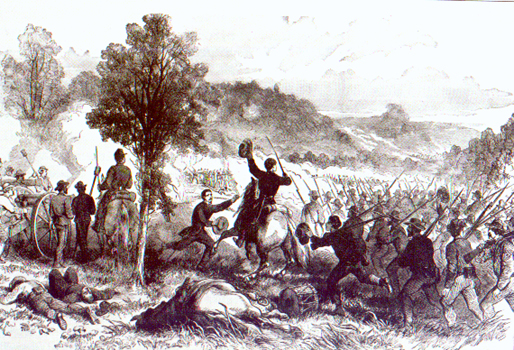A Brief Biography
of
General Nathaniel Lyon
Link:
New Jersey G.A.R. Archive
Link:
[ Index Page]
General Nathaniel Lyon was born July 14, 1818 in Ashford,
Connecticut. He was killed at the Battle of Wilson's Creek on August 10, 1861.
He was the Union's first General to die on the field of battle during the
Civil War.
Young Mr. Lyon spent his childhood working on the family
farm. Securing entrance to West Point, he began his military training on July
1, 1837 and graduated 11th in his class of 52 on June 22, 1841. Upon graduation
he chose the infantry for the prospect of more rapid promotion. Lyon was
promoted to the rank of 2nd Lieutenant on July 1, 1841 and was assigned to
Co. I, 2nd U.S. Infantry at Fort Russell in Florida to be engaged in actions
against the Seminole Indians. By the time he reported for duty, the Indians
had all but given up. The unit was transferred to Madison Barracks on Lake
Ontario in New York.
 In October of 1846, Lyon and his company joined the rest of the 2nd Infantry
and proceeded to the Rio Grande to join in the coming war with Mexico. On
April 16, 1847, he received his promotion to 1st. Lieutenant and was given
command of Co. D, 2nd Infantry. On September 14, 1847 Lyon with his troops
entered Mexico City. They had been told that Santa Anna had vacated the city,
but when the troops marched in, they were fired on from almost every roof
top. After securing the city, Lyon was ordered to New Orleans, and on September
18, 1847 Lyon received his promotion to Brevet Captain.
In October of 1846, Lyon and his company joined the rest of the 2nd Infantry
and proceeded to the Rio Grande to join in the coming war with Mexico. On
April 16, 1847, he received his promotion to 1st. Lieutenant and was given
command of Co. D, 2nd Infantry. On September 14, 1847 Lyon with his troops
entered Mexico City. They had been told that Santa Anna had vacated the city,
but when the troops marched in, they were fired on from almost every roof
top. After securing the city, Lyon was ordered to New Orleans, and on September
18, 1847 Lyon received his promotion to Brevet Captain.
In February of 1861, Lyon and his company were assigned
to bolster the weak defenses of the St. Louis Arsenal in Missouri. The St.
Louis Arsenal contained 60,000 muskets, 90,000 pounds of powder, 1 ½
million ball cartridges, 40 field pieces and the machinery for manufacture
of arms. Also located downtown was the Federal Sub-Treasury which housed over
a million dollars in gold and silver. These facilities were both severely
under guarded. Lyon was ordered to fortify the compounds. Lyon armed 2,500
volunteers loyal to the Union and inducted them into Federal service as per
his instructions from Washington. By general consensus, the Missouri Volunteers
elected Lyon General of their regiment.
On May 10, 1861 General Lyon gathered his command of
about 7,000 men and started on a six mile journey toward Camp Jackson, a
Confederate camp, arriving from several directions and surrounding the camp.
Lyon demanded the camp's unconditional surrender, which he received. For
the next month the City of St. Louis was on the edge of chaos with violence
erupting sporadically.
General stayed in Boontown refitting and re-supplying
his command until July 3, 1861. Hearing of a large Rebel Force moving against
him, on August 1 Lyon moved to intercept them. His men moved into position
undetected on the night of August 9 and surprised the Confederates in the
morning. General Lyon was directing troops on foot leading his horse. He was
struck in the leg and his horse was killed in a hail of bullets. Later General
Lyon was struck again, this time he was grazed on the right side of his head.
He staggered to the rear with the aid of another officer. Lyon reformed for
a second assault and decided to lead it himself. Taking a mount from an aid,
he lead the 2nd Kansas to the fight. Lyon was hit in the chest from only
a few yards and fell from his horse and died.
Major Sturgis then took command. The Confederates under
General Price mounted one final grand assault upon "Bloody Hill" only to be
repulsed for the third time. When the Confederates fell back to regroup, Major
Sturgis ordered a hasty retreat to Springfield. The exhausted Confederates
ordered no pursuit and the Battle of Wilson's Creek had ended.
The Battle of Wilson's Creek was bloodier than anyone
had imagined. In six hours of fighting the Federals had suffered 1,317 killed,
wounded and missing. The Confederate lost 1,230. News of General Lyon's death
and the Battle of Wilson's Creek spread across the country.
Flags flew at half mast as the funeral train stopped
in Cincinnati, Philadelphia, New York and Hartford. General Lyon was buried
September 5, 1861 in the family plot in Phoenixville, Connecticut. For his
actions General Lyon has since been known as the "Savior of Missouri."
Condensed by Clarence Smithcors
From:
Damned Yankee (The Life of General Nathaniel Lyon)
by: Christopher Phillips
University of Missouri Press
The Death of General
Lyon

The Steamer - General
Lyon
When
it set sail from Wilmington, NC on March 29, 1865 for Fortress Monroe,
Virginia.
The ship burned to the waterline off Cape Hatteras, NC
on
or about March 31, 1865

[Home]
[Members
& History] [Events
Calendar] [Cornelia
Hancock Auxiliary #10]
[Gen. Lyon's
Biography] [ NJ Camps]
[Membership] [Links]

 In October of 1846, Lyon and his company joined the rest of the 2nd Infantry
and proceeded to the Rio Grande to join in the coming war with Mexico. On
April 16, 1847, he received his promotion to 1st. Lieutenant and was given
command of Co. D, 2nd Infantry. On September 14, 1847 Lyon with his troops
entered Mexico City. They had been told that Santa Anna had vacated the city,
but when the troops marched in, they were fired on from almost every roof
top. After securing the city, Lyon was ordered to New Orleans, and on September
18, 1847 Lyon received his promotion to Brevet Captain.
In October of 1846, Lyon and his company joined the rest of the 2nd Infantry
and proceeded to the Rio Grande to join in the coming war with Mexico. On
April 16, 1847, he received his promotion to 1st. Lieutenant and was given
command of Co. D, 2nd Infantry. On September 14, 1847 Lyon with his troops
entered Mexico City. They had been told that Santa Anna had vacated the city,
but when the troops marched in, they were fired on from almost every roof
top. After securing the city, Lyon was ordered to New Orleans, and on September
18, 1847 Lyon received his promotion to Brevet Captain.